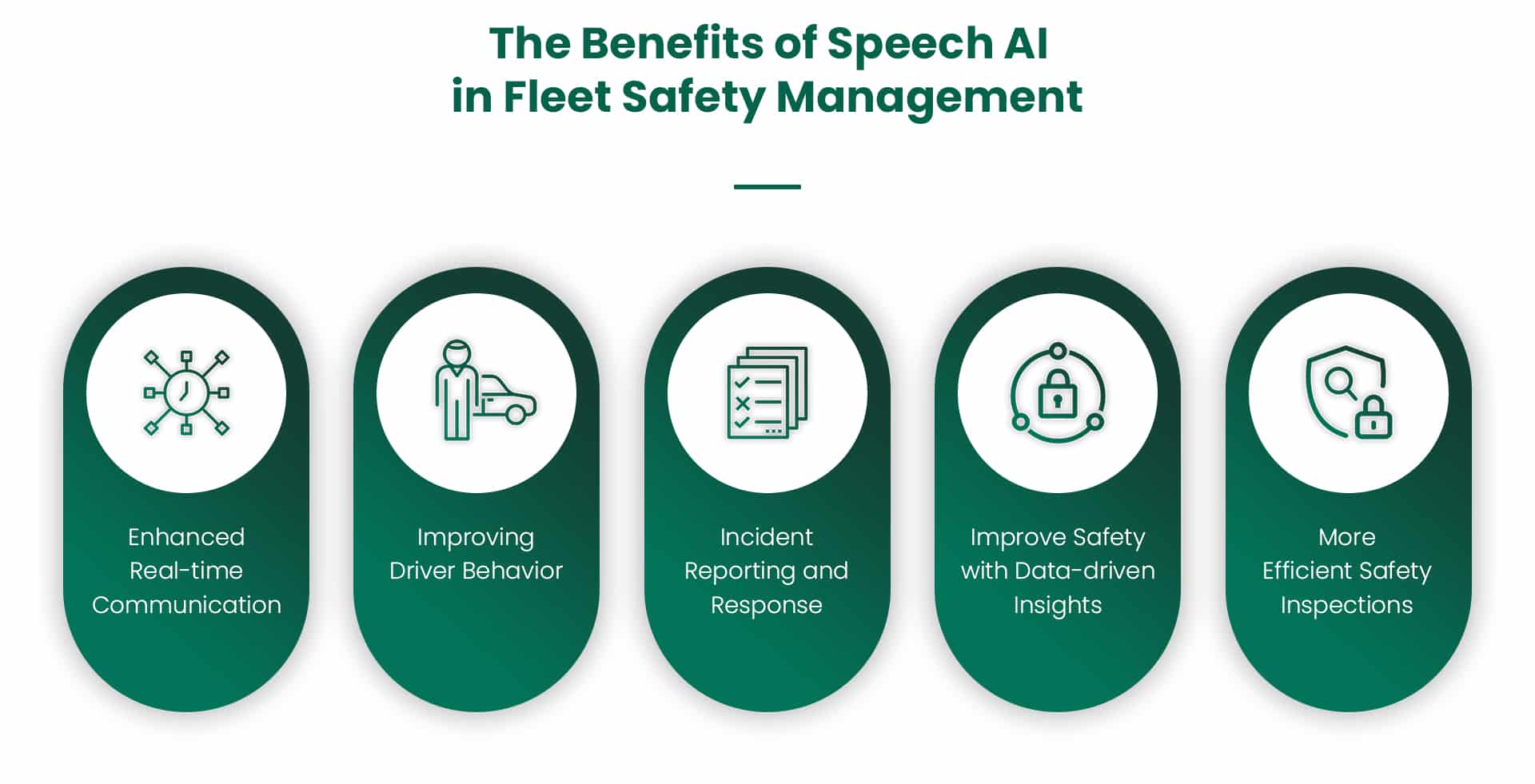Artificial intelligence (AI) is having a significant impact on the way fleet companies operate. With emerging technologies like facial analysis, predictive maintenance, and speech AI, fleet managers can better ensure the safety of their drivers and assets.
Speech AI is taking center stage in recent advancements in AI and fleet technology. Acting as a co-pilot, speech AI enables real-time communication between drivers and fleet managers, ensuring safer and more reliable workflows and live updating.
In this article, we’ll examine the way speech AI functions in a fleet safety management system and how it proactively mitigates risks and advances safety protocols. We’ll also look at how this is done with aiOla, a speech AI platform at the forefront of transformation in the fleet industry.
Understanding Fleet Safety Management Systems
A fleet safety management system is a system that’s designed to address and enhance safety concerns in a fleet of vehicles. Through a set of comprehensive frameworks, fleet safety management systems are essential to protect drivers, a business’s assets like vehicles, and public safety. Overall, fleet safety management systems mitigate risks related to managing a fleet and transportation operations.
Several components go into a fleet safety management system, each contributing to the fspeech aioverall security of drivers and vehicles. Some of the various components include:
- Ongoing driver training and education
- Vehicle maintenance and fleet inspection protocols
- Compliance with regulations
- Reporting on incidents
- Safety policy implementation
AI is offering a new way for fleet management companies to not only gather important data to make fleets safer but also implement new procedures that decrease the risk of safety incidents altogether.
Speech AI in Fleet Safety: A Brief Overview
Speech AI relies on spoken language to trigger actions or gather data. Using various technologies like natural language processing (NLP), natural language understanding (NLU), and automatic speech recognition (ASR), speech AI introduces a new set of functionalities to fleet safety management systems.
When speech AI is applied to fleet management, it introduces a wide spectrum of possibilities when it comes to data collection and safety procedures. Using voice recognition and various AI technologies, here are some of the ways speech AI can operate in a fleet safety management system:
- Real-time hands-free communication between drivers and management
- Incident reporting using only speech to record data
- Send and receive critical alerts through speech
- Quicker inspections with findings and data collected through speech instead of on paper
- Analysis of incoming data from driver, such as environmental conditions
- Data collection of road conditions and driver’s mental state and alertness with speech
Speech AI adds a layer of technological sophistication and cultivates a safer working environment that focuses on preventing accidents and safety issues before they arise. By turning the focus to speech to complete actions, communicate, and get real-time updates, drivers can be left to focus on the road while still completing their on-the-job tasks without removing their hands from the wheel.

AI creates new possibilities for fleet companies, opening the door to automated processes, cost-saving opportunities, and safer procedures. Looking at the benefits of speech AI in fleet safety, it’s clear to see why this new technology is being embraced. Here are some advantages of adopting speech AI in your fleet safety management system.
Enhanced Real-time Communication
Drivers and managers can communicate in real-time and entirely hands-free, allowing the driver to keep their focus on the road. This immediacy ensures that crucial information is relayed instantly, allowing for quicker response times, better safety, and more efficient planning and use of resources. According to industry estimates, AI can improve predictive maintenance systems and increase productivity by up to 20%, leading to cost savings and safer vehicles.
Improving Driver Behavior
Speech AI platforms can offer alerts about driver behavior, such as compliance with safety protocols, driving habits, or even potential hazards. According to the National Highway Traffic Safety Administration (NHTSA), distracted driving accounts for 8% of fatal crashes. By completing automated workflows through speaking, speech AI can help reduce distracted driving-related incidents.
Incident Reporting and Response
Incidents can be reported quickly using speech AI as drivers can communicate verbally, avoiding distractions and regular documentation. When an incident occurs, a speech AI system can gather data from the point of origin, like a vehicle, and send alerts to the right people, facilitating a quick response in an emergency.
Improve Safety with Data-driven Insights
With speech AI, there’s a wealth of otherwise untapped data to collect that can help determine factors like vehicle conditions, environmental factors, and driver behavior. Using this technology paired with other AI tools, like machine learning (ML), fleet companies can search for patterns and trends to make more informed decisions and implement targeted measures that enhance overall safety.
More Efficient Safety Inspections
With speech AI, drivers can verbally report on issues during inspections. This helps drastically reduce paperwork and manual documentation so that no safety concern falls through the cracks. Speech AI systems can also ensure that verbally documented inspection data gets sent to the right parties such as the mechanic when necessary, ensuring that issues are quickly addressed and in real-time.
Implementing Speech AI in Fleet Safety Management
Adopting a new technology into your organization is a challenging process. The best way to ensure smooth adoption is to be aware of all the different factors to implementing technology like speech AI into your fleet management systems, such as steps involved in implementation, training processes, and the challenges you may face along the way. Here are some factors to consider before implementation.
- Before beginning to adopt speech AI technology, assess your current systems to identify integration points to gauge compatibility. This will help you pick the right speech AI solution for your unique needs
- Look for a speech AI provider that can offer customized solutions for fleet management requirements
- Another point to consider when looking for a speech AI solution is that it won’t significantly disrupt your current workflows and procedures to the point where work is impacted
- Develop comprehensive training programs for drivers and all staff to ensure proper use of the speech AI system and its functionalities
- Continuously adapt your speech AI system and how it’s used with ongoing feedback from drivers and staff so that the technology can evolve alongside your business
- Stay aware of potential implementation challenges such as data security concerns, particularly when it comes to the storage or voice data, as well as initial employee resistance and downtime
aiOla: Tailored Speech AI for Your Fleet Safety Management System
aiOla is an AI-powered speech AI platform that turns words into actions. Using just the power of speech, fleet management companies can reduce the time they spend on manual workflows like vehicle inspections from minutes to just a few seconds. Since data is recorded from speech upon visual inspection, the result is more accurate and less prone to human error. It can better predict maintenance needs, making a fleet of vehicles safer overall.
In addition to streamlining inspections, aiOla can be helpful when it comes to driver communication. Drivers simply need to speak to communicate important data related to their vehicle, the road, weather conditions, or other information, meaning their focus is always on the road ahead. Speech data is collected in real-time so that dispatchers can make critical decisions related to logistical delays, routes, and even help gauge driver behavior and safety.
aiOla functions in any acoustic environment, including vehicles like loud trucks, relaying reliable data with a high level of accuracy. Additionally, aiOla can understand over 100 languages as well as any accent, dialect, or industry jargon, so the platform can easily adapt to your team’s needs, not the other way around.
A leading global shipping courier company turned to aiOla for help streamlining inspection processes and improving overall safety. After a smooth implementation process that didn’t disrupt existing workflows, the company saw a 70% decrease in safety incidents in addition to reducing inspection time and improving communication between team members. Thanks to aiOla, drivers can now report exactly what they see so that data on package issues and delays is instantly collected for quicker resolutions.
Better Fleet Safety With Speech AI
Ensuring the safety of your fleet is paramount to protecting your business from lost time and resources and against liabilities. With emerging technologies like speech AI, not only can you make your fleet workflows more efficient, but you can also enhance the safety procedures your team uses daily.
With aiOla, drivers can continue with their existing workflows while staying safe behind the wheel. Inspections can be completed just by having drivers walk around a vehicle and verbally reporting what they see. Finally, mechanics can receive real-time alerts, leading to fewer maintenance delays.
With quicker and more reliable inspections, workflows, and maintenance processes, the safety of all vehicles is easier to ensure, helping fleet operators remain more efficient. Since the system operates solely through the power of speech, adoption is a smooth process that doesn’t require a steep learning curve, meaning your team can benefit from automated speech-activated workflows and data collection without delay.
Book a demo with one of our experts to learn more about how aiOla makes fleet management safer.








